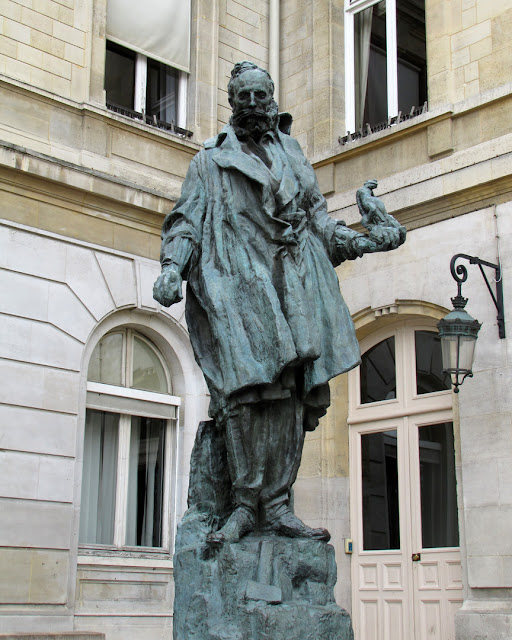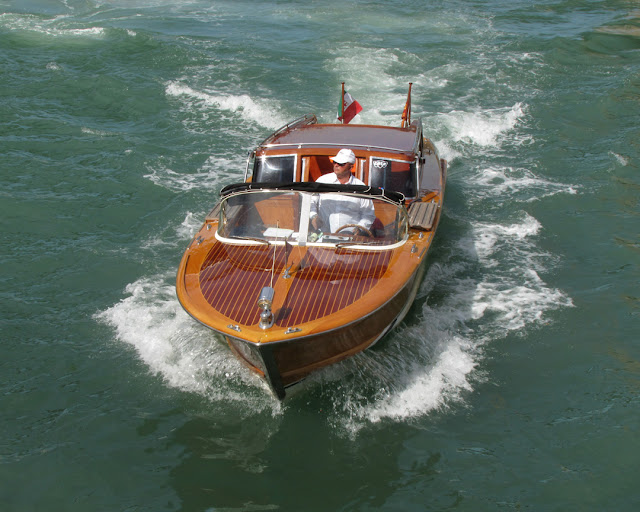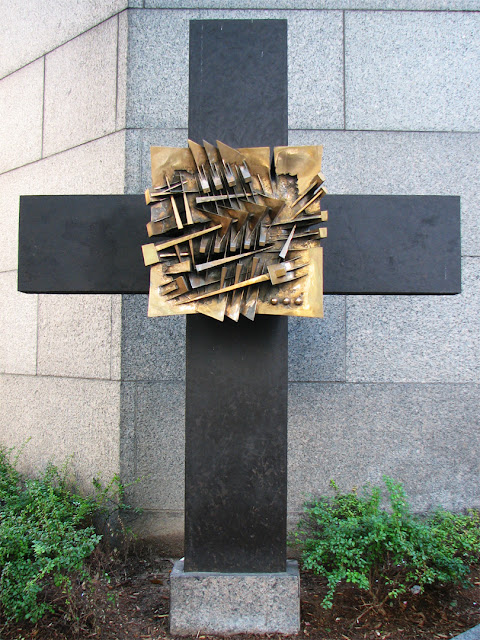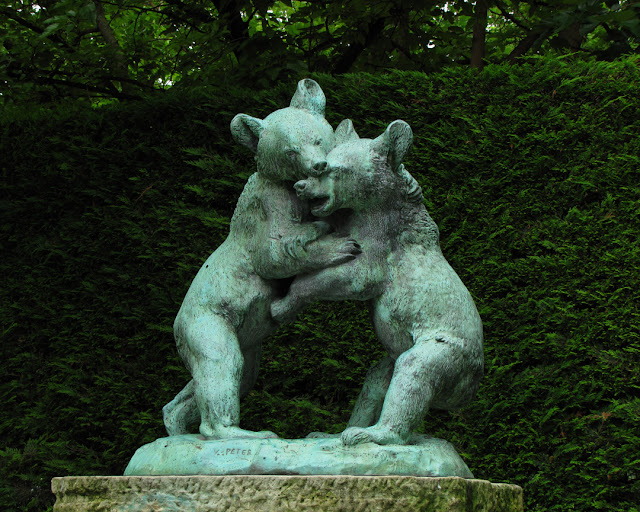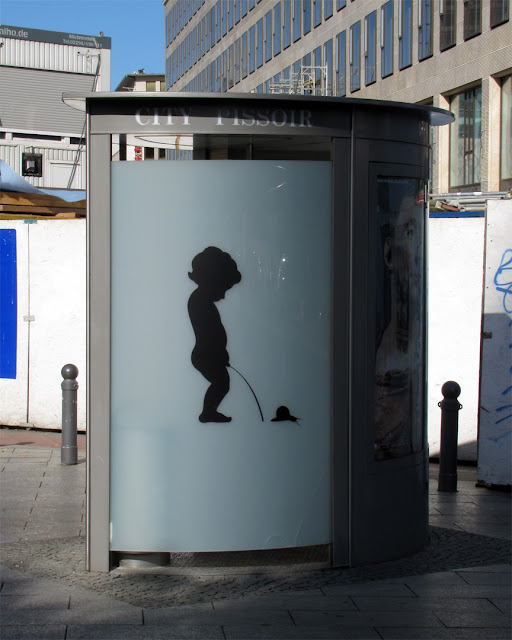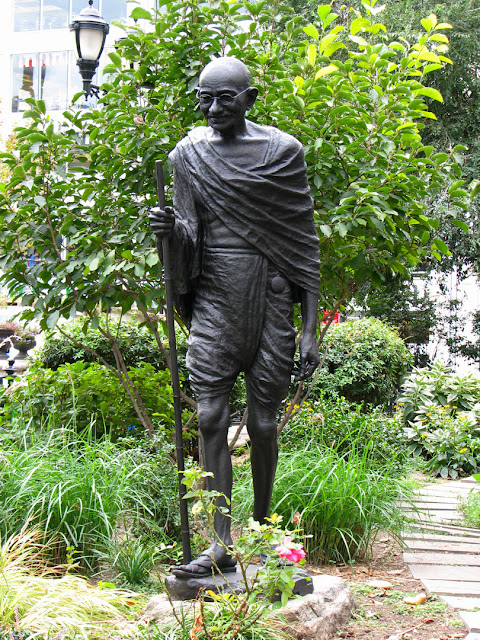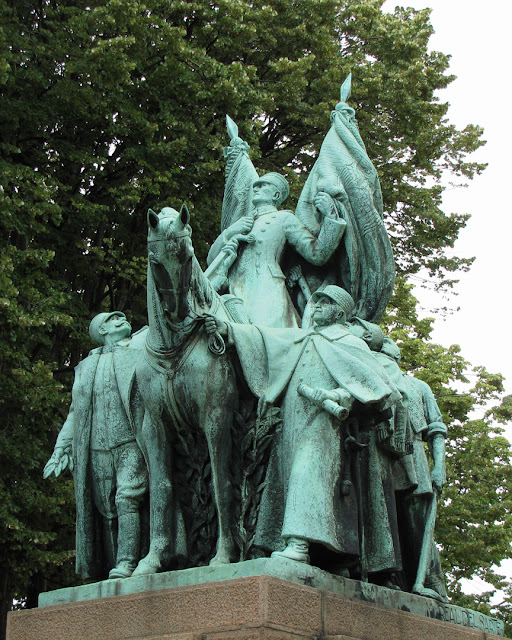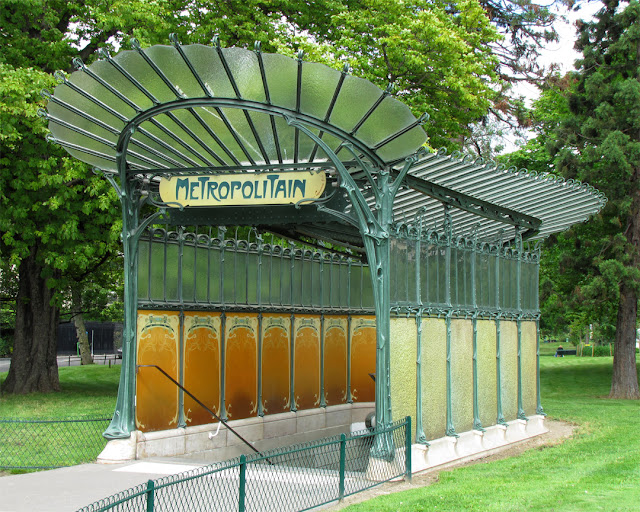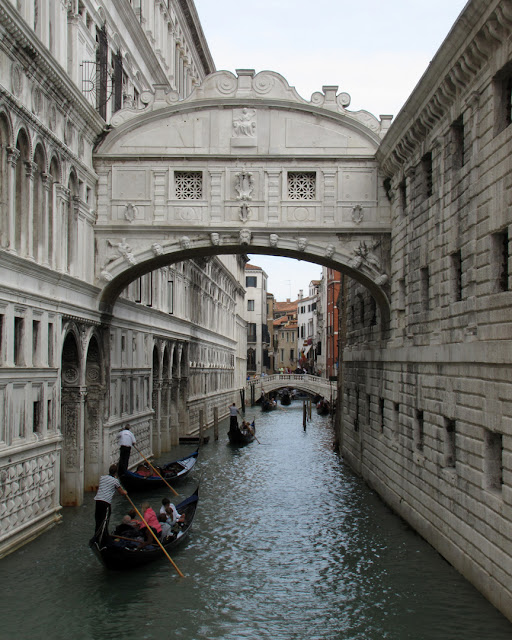Friday, November 30, 2012
Carpeaux at Work
Carpeaux au travail (Carpeaux at Work) by Antoine Bourdelle, 1910
Rue Péclet
Quartier Saint-Lambert, 15th arrondissement
Paris, July 2012
Thursday, November 29, 2012
Riva Aquarama
A Riva Aquarama speedboat on the Canal Grande (Grand Canal)
Seen from the Ponte della Costituzione (Constitution Bridge)
Venice, September 2012
“Venice’s water-taxis are sleek and speedy vehicles that can penetrate most of the city’s canals. Unfortunately their use is confined to all but the owners of the deepest pockets, for they are possibly the most expensive form of taxi in western Europe: the clock starts at €13 and goes up €1.80 every minute. All sorts of surcharges are levied as well: €5 for each extra person if there are more than two people in the party; €3 for each piece of luggage other than the first item; €8 for a ride between 10pm and 6am. There are three ways of getting a taxi: go to one of the main stands (at Piazzale Roma, the train station, Rialto and San Marco Vallaresso), find one in the process of disgorging its passengers, or call one by phone. If you phone for one, you’ll pay a surcharge, of course.” (Jonathan Buckley, The Rough Guide to Venice & the Veneto)
Wednesday, November 28, 2012
Paul-Löbe-Allee
Promenade with the Internationales Handelszentrum by Erhardt Gißke in background
Paul-Löbe-Allee
Berlin, September 2011
Tuesday, November 27, 2012
Robert Grosvenor
Robert Grosvenor, 1st Marquess of Westminster by Jonathan Wylder, 1998
On the plinth: “When we build let us think we build forever”
Wilton Crescent, Westminster
London, October 2009
“Therefore, when we build, let us think that we build for ever. Let it not be for present delight, nor for present use alone; let it be such work as our descendants will thank us for, and let us think, as we lay stone on stone, that a time is to come when those stones will be held sacred because our hands have touched them, and that men will say as they look upon the labour and wrought substance of them, ‘See! this our fathers did for us.’”
(John Ruskin, The Seven Lamps of Architecture, 1849)
Monday, November 26, 2012
Square Émile-Chautemps
Sign of Square Émile-Chautemps
Square Émile-Chautemps
Quartier des Arts-et-Métiers, 3rd arrondissement
Paris, July 2012
Sunday, November 25, 2012
Palazzo Contarini del Bovolo
External spiral staircase by Giorgio Spavento
Palazzo Contarini del Bovolo
Calle Contarini del Bovolo, San Marco
Venezia, September 2012
“On the wall of the alley on the south side of Campo Manin, a sign directs you to the staircase known as the Scala del Bovolo – bovolo is the word for snail shell in Venetian dialect. External staircases, developed originally as a way of saving space inside the building, were a common feature of Venetian houses into the sixteenth century, but this specimen, dating from around 1500, is the most flamboyant variation on the theme.” (Jonathan Buckley, The Rough Guide to Venice & the Veneto)
Saturday, November 24, 2012
Konrad Adenauer
Konrad Adenauer statue by Helga Tiemann
Adenauerplatz, Charlottenburg-Wilmersdorf
Berlin, September 2011
“Konrad Hermann Joseph Adenauer was a German statesman. As the first Chancellor of Germany (West Germany) from 1949 to 1963, he led his country from the ruins of World War II to a powerful and prosperous nation that forged close relations with old enemies France and the United States. In his years in power Germany achieved prosperity, democracy, stability and respect. He was the first leader of the Christian Democratic Union (CDU), a coalition of Catholics and Protestants that under his leadership became and has since remained the most dominant in the country.” (Konrad Adenauer, Wikipedia)
Friday, November 23, 2012
Exterior Cross
Exterior Cross by Arnaldo Pomodoro
St. Peter Lutheran Church
Lexington Avenue / 54th Street
New York, September 2008
“The Exterior Cross was designed by internationally renowned sculptor Arnaldo Pomodoro of Milan, Italy. Mr. Pomodoro's striking design links old with new through a skillful blend of traditional and modern forms and materials. The ancient cross form is finished in a rich, rust-colored bronze. Its piercing central wedge shape, or ‘nail,’ contrasts with the simple strong cross form. The nail is contemporary in its highly polished finish, with an abstraction of Christ's body and the crucifixion instruments of torture on its front surface.” (St. Peter’s Church, New York Architecture)
Thursday, November 22, 2012
Les oursons
“Les oursons” (The Bear Cubs) by Victor Peter
Square Saint-Lambert
Quartier Saint-Lambert, 15th arrondissement
Paris, July 2012
Wednesday, November 21, 2012
Ponte dei Pugni
Ponte dei Pugni (Bridge of Fists)
Rio di San Barnaba, Dorsoduro
Venice, October 2012
“There was one game, however, that more than any other symbolised the stability and strength of the Venetian state. It was known as la guerra dei pugni or the war of the fists, fought between the inhabitants of the various territories and neighbourhoods. There were the Rialtini and the Cannaruoli, the Bariotti and the Gnatti. But the largest division of all lay between the Castellani—in the western parishes of Cannaregio, Castello, S. Marco and Dorsoduro—and the Nicolotti in the eastern parishes of S. Croce and S. Polo. The dominant factions were the fishermen of the Nicolotti and the shipbuilders of the Castellani. Their internecine rivalries have already been described. A team from each of these territories met for battle on a chosen bridge, while thousands of spectators lined the streets and houses beside the canal. Dumplings and chestnuts were served to the crowds by street vendors. It was a glorified fist-fight in which the object was to hurl opponents into the water and to gain possession of the bridge.” (Peter Ackroyd, Venice: Pure City)
Tuesday, November 20, 2012
City Pissoir
City Pissoir, public toilet
Breitscheidplatz, Charlottenburg-Wilmersdorf
Berlin, September 2011
See also: Café Achteck
Monday, November 19, 2012
St Saviour's Church
St Saviour's Church
Walton Place, Knightsbridge
London, October 2009
“Intermission, in the parish church of St Saviour's, London SW3 1SA, has a variety of dynamic spaces for worship, performances, exhibitions, workshops and meetings. Intermission is a faith community that goes beyond the walls of St Saviour's. It is a community of Christian performers, writers and artists committed to the deepening understanding of God through Arts Media.” (Intermission)
Sunday, November 18, 2012
Le Mur des Justes
Le Mur des Justes (The Wall of the Righteous)
Mémorial de la Shoah (Shoah Memorial)
Allée des Justes
Rue du Grenier-sur-l'Eau, Le Marais
Quartier Saint-Gervais, 4th arrondissement
Paris, July 2012
“Israel’s Prime minister Ehud Olmert and his French counterpart Dominique de Villepin dedicated Wednesday the “Mur des Justes” (Wall of Righteous) on which 2,693 names of French people who protected or saved Jews during WWII are engraved. The 40-metre-long wall, located at the Shoah Memorial in Paris, bears 37 bronze plates where the names of these people are written, including the place where they saved Jews. It is located on a street renamed the “Avenue of the Righteous” by the Paris municipality a few years ago. The Memorial, in the historic Jewish quarter of the Marais, was inaugurated by President Jacques Chirac in January 2005 on the occasion of the 60th anniversary of the liberation of Auschwitz.” (Olmert dedicates “Wall of the Righteous” in Paris, EJP)
Saturday, November 17, 2012
Piazzetta dei Leoncini
Red marble lions by Giovanni Bonazza, 1722
Piazzetta dei Leoncini, Piazza San Marco
Venice, October 2012
“To your right as you face the Torre is the Piazzetta Giovanni XXIII, familiarly known as dei Leoncini, after the two eighteenth-century marble lions – if you can’t see them immediately, it’s because they’re smothered in children.” (Jonathan Buckley, The Rough Guide to Venice & the Veneto)
Friday, November 16, 2012
Thursday, November 15, 2012
Mohandas Gandhi
Mohandas Gandhi by Kantilal B. Patel, 1986
Gandhi Gardens, Union Square Park
New York, October 2007
See also: Mahatma Gandhi
“This bronze sculpture depicting Mohandas Gandhi (1869–1948) was sculpted by Kantilal B. Patel (born 1925). After its dedication on October 2, 1986, the 117th anniversary of Gandhi’s birth, the sculpture joined monuments to Washington, Lafayette, and Lincoln in Union Square Park as a quartet of works devoted to defenders of freedom. (...)
Clad in sandals and a cotton dhoti, Gandhi’s dress illustrates his Hindu asceticism as well as his support for Indian industries. After its installation the monument became an instant pilgrimage site, with an annual ceremony taking place on Gandhi's birthday, October 2.” (Gandhi, Union Square Park, City of New York Parks & Recreation)
Wednesday, November 14, 2012
Pierre-Jean de Béranger
Statue of Pierre-Jean de Béranger by Henri Lagriffoul, 1953
Square du Temple
Quartier des Enfants-Rouges, 3rd arrondissement
Paris, July 2012
This statue replaced a bronze one by Amédée Doublemard, melted in 1941 during the German occupation of Paris in World War II.
Tuesday, November 13, 2012
Gloria di San Vitale
“Gloria di San Vitale” (The Glory of St. Vidal) by Vittore Carpaccio, 1514
Main altarpiece of the former church of San Vidal, San Marco
Venice, October 2012
“No longer a functioning church, San Vidal has found a use as a concert hall for Interpreti Veneziani, Venice’s premier interpreters of Vivaldi, played on original 18th- to 19th-century instruments. Built as a monument to the glories of God and two Venetian dogi, this stately church is best known for the masterpiece behind the main altar: St Vitale on Horseback and Eight Saints, an uncharacteristically gore-free work by Vittore Carpaccio featuring traces of his signature traffic-light red and a miniaturist’s attention to detail.” (Lonely Planet, Venice)
Monday, November 12, 2012
The Vistula
“Die Weichsel” (The Vistula), Neptunbrunnen (Neptune Fountain) by Reinhold Begas
Rathausstraße / Spandauer Straße
Berlin, September 2011
See also: Neptunbrunnen - The Rhine - The Oder - The Elbe
Sunday, November 11, 2012
Charlie Chaplin
Charlie Chaplin statue by John Doubleday, 1981
Leicester Square
London, October 2009
The comic genius
who gave pleasure
to so many
who gave pleasure
to so many
Charles Spencer Chaplin, 16 April 1889 - 25 December 1977, comic actor, director and producer.
Charlie Chaplin was born in Walworth, London into a music hall family. He joined a troupe of child dancers, 'Eight Lancashire Lads' at the age of 8. At 17, whilst on tour in America, he joined the Mack Sennett Keystone Company motion picture company. His acting technique was characterised by a high degree of pathos, accentuated in the then silent movies, but he was unwilling later to adapt his style to the 'talkies'. His success enabled him to co-found United Artists in 1919.
His major films included The Tramp (1915), Shoulder Arms (1918), The Gold Rush (1925), City Lights (1931), Modern Times (1936) and The Great Dictator (1940). He was knighted in 1975.
The statue is by John Doubleday and was unveiled by Sir Ralph Richardson in April 1981.
(From the chrome plaque on the front of the plint)
Saturday, November 10, 2012
Fontaine Victor-Hugo
Fontaine Victor-Hugo by François Davy (architect) and Max Ingrand (master glassmaker)
Place Victor-Hugo
Quartier de Chaillot, 16th arrondissement
Paris, July 2012
A monument to Victor Hugo once stood in the center of the square, where the fountain is now. The bronze statue was melted during the German occupation of Paris in World War II.
Friday, November 9, 2012
Saint Theodore
Statue of Saint Theodore on the western column
(The original is inside the Doge's Palace)
Piazzetta San Marco
Venice, October 2012
“On the other column is poised the statue of Saint Theodore, the original patron saint of Venice. If you were to come closer to this image, you would notice that it is not in any sense the work of one hand. The head is of Parian marble, and is believed to represent Mithridates, king of Pontus; the torso is a Roman piece from the time of Hadrian the Great; the dragon, or crocodile, is in the Lombardic style from the first half of the fifteenth century. It is a glorious, and apparently haphazard, exercise in historical assembly. It deserves to be on its column. Once again it is an image of Venice itself.” (Peter Ackroyd, Venice: Pure City)
Thursday, November 8, 2012
Jakob Mierscheid Footbridge
Marie-Elisabeth-Lüders-Steg (Marie-Elisabeth-Lüders Footbridge)
also Jakob-Mierscheid-Steg (Jakob Mierscheid Footbridge)
Nicknamed after the fictitious politician Jakob Maria Mierscheid
Berlin, September 2011
After the parliament moved to Berlin, two new office buildings for members of parliament were connected with a pedestrian bridge over the Spree river. This bridge was nicknamed the “Mierscheid Bridge”. Attempts to mark it with an official plate were said to have failed because “the nails were nuts” (pun on Niete meaning nut/rivet, a blank in lottery or a person that is unable to accomplish anything). (Jakob Maria Mierscheid, Wikipedia)
Wednesday, November 7, 2012
To IKEA by Boat
New York Water Taxi advertising the IKEA Express Shuttle
Hudson River
New York, September 2008
See also: Red Hook
“What’s certain is that Red Hook residents aren’t the only ones intensely watching Ikea’s opening; the Daily News has it that other big box stores have been encouraged by Ikea’s opening victory here. If Wal-Mart and Target follow Ikea's lead, Red Hook’s post-shipping era could skip over the long-anticipated full-gentrification stage to become something else entirely: a sort of big box shopping destination that’s more like a factory outlet mall than a neighborhood. Or is a balance between big business, small business, and residential interests possible? As Ikea's first day draws to an end, it's still an open question.” (Big Box Begs Big Questions, Gothamist, June 2008)
Tuesday, November 6, 2012
Alexandre Ier de Yougoslavie
Monument to Alexander I of Yugoslavia with Peter I of Serbia and Maréchal Franchet d'Esperey
by Maxime Real del Sarte, 1936
Place de Colombie
Quartier de la Porte-Dauphine, 16th arrondissement
Paris, July 2012
See also: Maréchal Joffre
“A cameraman happened to be at exactly the right spot when King Alexander, in Marseilles at the beginning of a state visit to France, was being driven through the streets in a car with Louis Barthou, the French foreign minister. He was only a few feet away when a gunman jumped out of the crowd and shot both the king and the chauffeur dead. The car stopped, with the king slumped in the back, while the cameraman continued filming. Louis Barthou was shot, too, and mortally wounded, possibly by mistake by a French policeman in the general confusion. The assassin, Vlado Chernozemski, was struck down with a sabre by a French mounted officer and beaten to death by the crowd or shot by the police or both, according to varying accounts. He was a 36-year-old Bulgarian who belonged to a Macedonian revolutionary organisation, which wanted to secede from Yugoslavia, and was allegedly in league with Croatian separatists, the Ustashas, who were backed by Benito Mussolini’s Italy.” (Alexander I of Yugoslavia assassinated, History Today)
Monday, November 5, 2012
Squero di San Trovaso
Squero di San Trovaso (San Trovaso Boatyard)
Rio San Trovaso, Dorsoduro
Venice, October 2012
“One of the most interesting (and photographed) sights you'll see in Venice is this small squero (boatyard), which first opened in the 17th century. Just north of the Zattere (the wide, sunny walkway that runs alongside the Giudecca Canal in Dorsoduro), the boatyard lies next to the Church of San Trovaso on the narrow Rio San Trovaso (not far from the Accademia Bridge). It is surrounded by Tyrolean-looking wooden structures (a true rarity in this city of stone built on water) that are home to the multigenerational owners and original workshops for traditional Venetian boats.” (Frommer's Northern Italy including Venice, Milan & the Lakes, 3rd Edition)
Sunday, November 4, 2012
The Elbe
“Die Elbe” (The Elbe), Neptunbrunnen (Neptune Fountain) by Reinhold Begas
Rathausstraße / Spandauer Straße
Berlin, September 2011
See also: Neptunbrunnen - The Rhine - The Oder - The Vistula
Saturday, November 3, 2012
Postman's Park
Memorial to Heroic Self Sacrifice
Postman's Park
King Edward Street, City of London
London, January 2007
| Thomas Griffin fitters labourer April 12, 1899 In a boiler explosion at a Battersea sugar refinery was fatally scalded in returning to search for his mate | Walter Peart, driver and Harry Dean, fireman of the Windsor Express on July 18, 1898 Whilst being scalded and burnt sacrificed their lives in saving the train |
| Mary Rogers stewardess of the Stella Mar 30 1899 Self sacrificed by giving up her life belt and voluntarily going down in the sinking ship | Alice Ayres, daughter of a bricklayer's labourer who by intrepid conduct saved 3 children from a burning house in Union Street, Borough, at the cost of her own young life April 24, 1885 |
External links: List of tablets on the Memorial to Heroic Self Sacrifice (Wikipedia)
Friday, November 2, 2012
La libellule Guimard
Art Nouveau aedicule by Hector Guimard
Porte Dauphine station, Line 2 of the Paris Métro
Avenue Foch
Quartier de la Porte-Dauphine, 16th arrondissement
Paris, July 2012
“Une libellule déployant ses légères ailes” (A dragonfly unfolding its light wings)
Georges Bans, journalist
Thursday, November 1, 2012
Bridge of Sighs
Ponte dei Sospiri (Bridge of Sighs)
Rio de la Canonica
Ponte del Rimedio in background
Venice, September 2012
| “I stood in Venice, on the Bridge of Sighs; A palace and a prison on each hand: I saw from out the wave her structures rise As from the stroke of the enchanter's wand: A thousand years their cloudy wings expand Around me, and a dying glory smiles O'er the far times when many a subject land Looked to the winged Lion's marble piles, Where Venice sate in state, throned on her hundred isles!” |
(Lord Byron, Childe Harold's Pilgrimage, Canto IV, Stanza I)
Subscribe to:
Comments (Atom)

